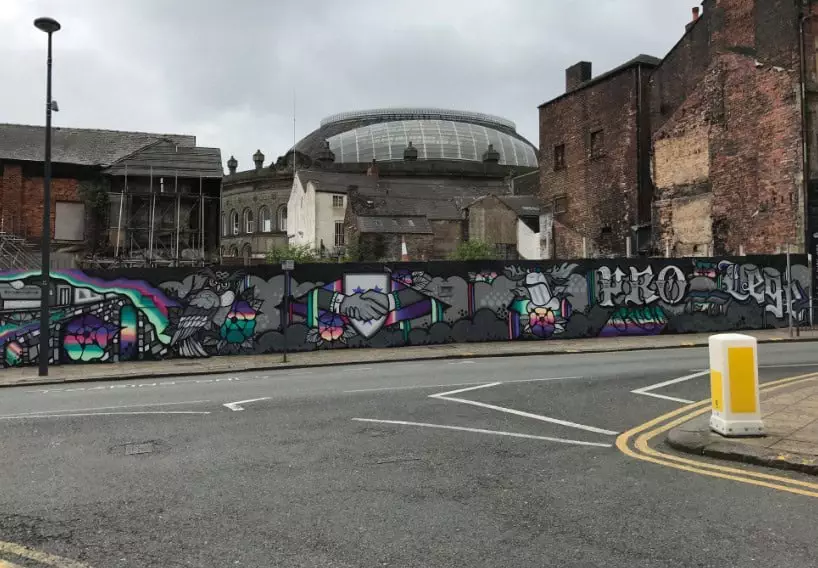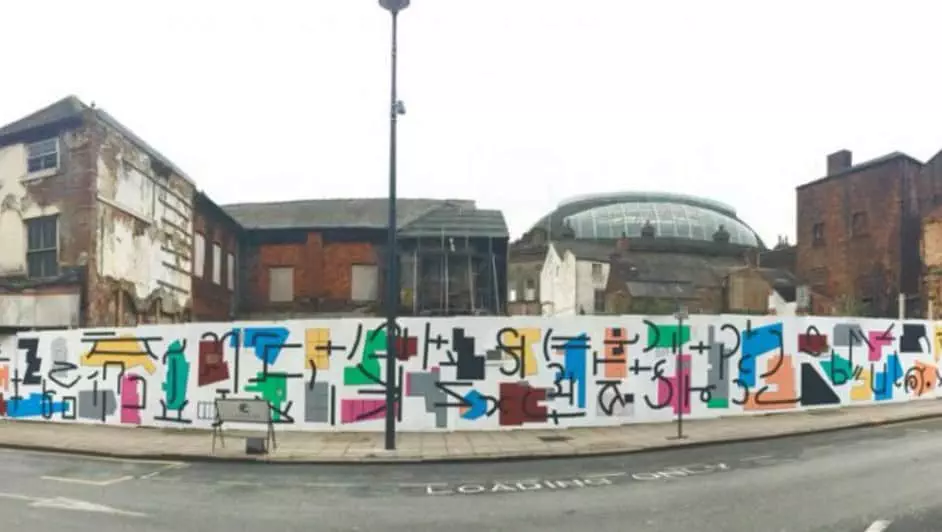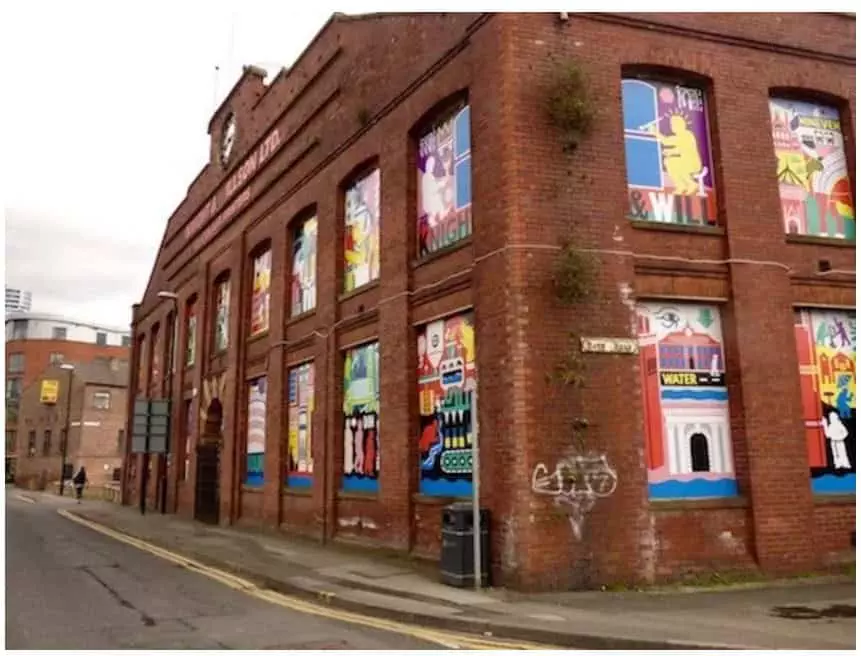
We were included in a Retweet yesterday of Leeds BID’s article on a new piece of street art on Kirkgate.
@LeedsBID @EastStreetArts @KirkgateMarket @LeedsMarkets @lee_wilkinson2 @Culture_bean @culturevultures @Leeds_City more unsightly graffiti!
— Eye's Open (@havingasay123) May 16, 2017
My guess is it’s not a positive comment.
“I think it depends on your point of view”, I responded. I’ve had years of mental health training. It often comes in handy.
Like a lot of street art this one’s bound to divide opinion. I’m not even sure what I think of it myself yet. I really liked the piece that it’s replaced – I’m not the only one there – and all I can say is that it’ll probably grow on me. But “unsightly”?

Street art tends to be found in “unsightly” places. Like Kirkgate right now, like Water Lane (this one I love!)

and like Marshall Street.


Admission of interest time, I had something to do with the latter, though I’m not saying what exactly in case the owners are reading (it’s proper graffiti. Permission wasn’t asked. Council funding was not applied for.). But I think most people passing by Temple Works would agree that the “graffiti” is an improvement. I saw it being done and I can vouch for the fact that there’s some genuine skill and thought and creativity gone into it.

I don’t think everyone has to agree though.
I’d be quite happy if someone thought it was rubbish. A blot on the landscape. A hideous addition to Holbeck’s illustrious heritage.
The point about this sort of thing is that it is temporary, it’s eye-catching

and most of all, it’s experimental.

Anyone who produces, commissions or funds experimental art and thinks that everything they do is vibrant, iconic or game-changing doesn’t really get what experimental means. A lot will be crap. Just no good. Unsightly.
If you ever visited Temple Works you’ll know what I mean.
We did piles of crap. Huge, steaming, stinking tons of shit. I’m naming no names.
That’s part of the fun.
Sometimes you just can’t see it yourself. Someone else has to point it out; “hey, that’s some unsightly crap you just did.” And we should encourage that. I’d rather know. Saves trouble next time. Saves paint too.
But sometimes people are wrong too. Not wrong for coming out and saying it – that’s always to be applauded – but wrong because the thing isn’t so bad, it just takes a bit of getting used. And after a while everyone loves it.
Remember the Brick Man?
So, let’s pat the “unsightly” social media critic on the back and thank him for at least taking the time to pay attention. That’s all you can ask in the end.
Even though he’s wrong.
Interesting article Phil. Once I had deciphered the underlying argument I began to wonder whether it could be broadened out to highlight other aspects of Leeds’s urban visual culture.
So, working with what you wrote I discovered some underlying binary categories which go something like this;
Good street art would be spontaneous, experimental, temporary and should be open to criticism to establish whether it is attractive in some way. Not so good street art would be curated or commissioned by someone for their own ends or through a misplaced sense of altruism, clichéd in appearance, permanent and met by bored apathy by its observers so no one feels committed enough to comment on whether it is unsightly or attractive.
Hmmm so what other aspects are there to Leeds’s urban visual culture besides this so-called Street Art I wondered?
Four came to mind – the Commercial consisting of things like hoardings, shop fronts, architecture of neo-liberalism: the Subversive, things like graffiti, some street art, unauthorised posters: the Collective examples being commissioned public art, civic and heritage buildings, memorials, the designer public realm and finally the Underside which would be abandoned buildings, empty sites the natural scenes of decay.
So, how do your categories help to explain my wider aspects of urban visual culture?
The Commercial is highly curated and commissioned. It is likely to use the common visual clichés of desire and even in terms of architecture it can be called temporary. It is unsightly or attractive according to taste and only in exceptional circumstances is it criticised e.g. Leeds’s ugliest building contest. It is not subversive except in superficially eating itself as trends change. It is collective only in the sense that we all buy into the values it represents to a greater or lesser extent. When we see the pealing poster or the ghost sign of the half- forgotten brand we are approaching the underside.
The Subversive can be seen in your description of Temple works. This is an easy one it is spontaneous, experimental, temporary and likely to receive spoken criticism or even physical censorship/ erasure by the authorities. Remember the illegal posters discussion on this web page? It is non-commercial, non-collective in the sense I use the term and is often found around the Underside.
The Collective stuff is curated, chosen by experts to represent our heritage, civic or national identity or representing good taste and sound sustainable values. Clichéd, I tend to think so, Victoriana in, modernism out. It is claimed to be always attractive and should be as permanent as possible unless it is “at risk”. It is non-subversive, and constantly proclaimed to be essential to “place making” and the attractive urban environment. it is often tied to the commercial world through its tourism impacts. it is the opposite to the underside.
The Underside of ruination comes about through the “natural” economic and political workings of the city itself so although there is an underlying economic logic to why some sites are favoured and other not I would say the Underside is spontaneous although it has been increasingly curated and rendered as Cliché by urban explorers, photographers and psycho-geographers. The underside is almost universally condemned as unsightly and thus subject to spoken criticism. The underside may be either temporary or semi-permanent. it is the opposite and affront to the collective
Street Art as such can be found into any of the above categories.
So overall can we say anything about these different realms of urban visual culture to tie things together. Is it Art? Well, some of it is held out to be Art in the sense Public Art or Street Art so we would have to say that this notion applies to some of it. If people are tearing Banksy’s off the walls to sell it then it must be Art. For myself, I did go around a Light Art show in Holbeck a few years ago. A few items remain which I wouldn’t mind having on my roof.
Most of the rest including most of the BID stuff in your article I would put into any or all of three other categories: decoration, disguise or propaganda. So, most of the examples you give (apart from Temple Mills) I would say are at best decorative that is if you find them attractive. They are, at the same time often a form of urban disguise: either in the general sense of acting as pleasant distraction from the world of poverty and homelessness which may literally lie behind them or covering up the more immediate example of urban market failure of an unused site. Most, including obviously the commercial and the collective, and I would include some which might claim to be subversive, I would suggest is little more than a form of urban propaganda.
Only the Underside speaks for what it really represents.
Thanks for the article Phil as you can tell it got the grey matter stirring.